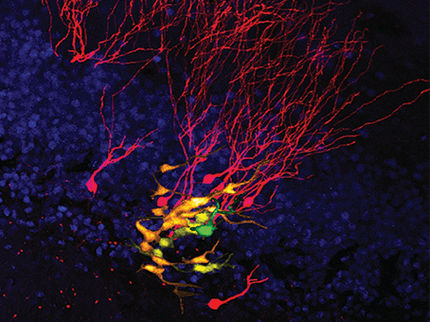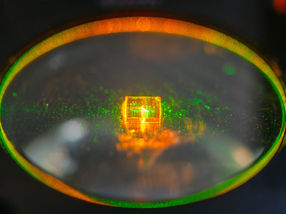Brain reward molecule helps learning to avoid unpleasant experience
The brain chemical dopamine regulates how mice learn to avoid a disagreeable encounter, according to new research from the Perelman School of medicine at the University of Pennsylvania. "We know that dopamine reinforces 'rewarding' behaviors, but to our surprise, we have now shown that situations that animals learn to avoid are also regulated by dopamine," said senior author John Dani, PhD, chair of the department of Neuroscience.

Dopamine innervation into the hippocampus. Green denotes general catecholamine -- a general name for dopamine -- innervation of the CA1 region of the hippocampus. Yellows denotes dopamine nerve endings in the same region. Scale bar is 50 microns.
John Dani, Ph.D., Perelman School of Medicine, University of Pennsylvania
Special neurons in the brain send out a burst of dopamine in both negative and positive situations. However, the exact way in which dopamine neurons are wired and connected to the brain center called the hippocampus remains controversial among neuroscientists. Knowing exactly how the neurotransmitter dopamine shapes memory and behavior in association with an event or the surrounding environment is important to better understand such conditions as post-traumatic stress syndrome.
"We showed in mice that a special circuit in the hippocampus has flexibility in combining with environmental input to shape behavior during an experiment in which the mice learn to avoid an unpleasant experience," Dani said. "This is the first time that we have been able to show, as proof of principle, that the dopamine circuitry is also involved in learning to avoid aversive situations. "
Prevailing Questions
In previous animal experiments, when mice experience an unexpected reward, for example discovering a tube in which they can obtain a sugar-water treat, a burst of dopamine is emitted in the brain. The debate among neuroscientists centers on whether the neurotransmitter only shapes behavior when an animal is receiving a positive reward or if the neurotransmitter is also involved in shaping the way an animal learns how to avoid an uncomfortable situation.
The team found that if the mice encounter an negative stimuli, a subgroup of neurons fires and releases dopamine in conjunction with the aversive environmental input. They also showed that when the dopamine signal to the hippocampus is chemically blocked in the mice, it prevents them from learning to avoid the negative stimulus. However, if the dopamine signal is chemically boosted in the mice, they remember to avoid the aversive event longer.
"The bottom line of our study is that dopamine plays a role in both conditions, and that dopamine enables mice to learn and remember to avoid the negative situation, in this case avoid a light foot shock in one room of a two-room enclosure."
Original publication
John I. Broussard, Kechun Yang, Amber T. Levine, Theodoros Tsetsenis, Daniel Jenson, Fei Cao, Isabella Garcia, Benjamin R. Arenkiel, Fu-Ming Zhou, Mariella De Biasi, John A. Dani; "Dopamine Regulates Aversive Contextual Learning and Associated In Vivo Synaptic Plasticity in the Hippocampus"; Cell Reports; 2016
Most read news
Original publication
John I. Broussard, Kechun Yang, Amber T. Levine, Theodoros Tsetsenis, Daniel Jenson, Fei Cao, Isabella Garcia, Benjamin R. Arenkiel, Fu-Ming Zhou, Mariella De Biasi, John A. Dani; "Dopamine Regulates Aversive Contextual Learning and Associated In Vivo Synaptic Plasticity in the Hippocampus"; Cell Reports; 2016
Organizations
Other news from the department science

Get the analytics and lab tech industry in your inbox
By submitting this form you agree that LUMITOS AG will send you the newsletter(s) selected above by email. Your data will not be passed on to third parties. Your data will be stored and processed in accordance with our data protection regulations. LUMITOS may contact you by email for the purpose of advertising or market and opinion surveys. You can revoke your consent at any time without giving reasons to LUMITOS AG, Ernst-Augustin-Str. 2, 12489 Berlin, Germany or by e-mail at revoke@lumitos.com with effect for the future. In addition, each email contains a link to unsubscribe from the corresponding newsletter.



























































